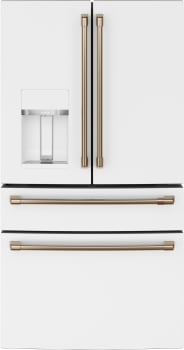With a generous 26cu. ft. capacity and featuring our Door-in-Door® design, this side-by-side refrigerator maximizes food storage space to accommodate all of your family’s food. From post-workout protein shakes to after-school snacks, LG’s Door-in-Door® design keeps all your favorites at your fingertips while reducing cold air loss to help keep foods, fresher longer and conserve on precious energy —all with the push of a button. It’s designed with convenient slide-out and folding shelving, tilting and adjustable door bins, and multiple crisper drawers— to help facilitate organization, so you can find just what you need in a snap. Plus, it comes with sophisticated LG styling and features like an intuitive LED display, contoured doors, and Smart Cooling System helps keep your food fresher..
Ultra-Large Capacity, 26 cu. ft.
Get more space for groceries with our Ultra-Large Capacity (26 cubic feet) refrigerators.
Door-in-Door®
The LG Door-in-Door® provides quick and easy access to foods and beverages.
ColdSaver™ Panel
Door-in-Door® with ColdSaver™ Panel reduces cold air loss to extend the freshness of food.
Slim SpacePlus® Ice System
The LG Slim SpacePlus® Ice System provides ample shelf space.
Tall Ice & Water Dispenser®
Finally, an ice & water dispenser that can accommodate just about any container.
Smart Cooling® System
Smart Cooling® system is designed to monitor and maintain conditions to help keep food fresh.
Premium LED Lighting
LED panels located on the rear of the refrigerator provide an exceptionally bright interior and saves energy over traditional lighting.
Humidity Control Crispers
Humidity-controlled crispers are a great place to keep fruits, vegetables, and more.
Sophisticated Style & Design
Details matter more than ever when creating a distinctive kitchen.
SmartDiagnosis™
Troubleshoot quickly and efficiently with SmartDiagnosis™.
Multi-Air Flow System
Multi-Air Flow Freshness System designed to monitor and maintain conditions to help keep food fresh.






by John
Im giving the overall experience a 4/5 stars for the simple fact that the day I went in to buy my refrigerator I inquired about opening up a Best Buy credit card. The salesperson was very nice and polite about everything and answered all my questions, the only downside of the whole experience is that when I tried to apply for the Best Buy credit card the process took over 1 hour just for someone to answer and see if I could apply. I guess that day the bank was having technical issues with their systems and were taking a long time to process applications. At the end I never got a definite answer and they told me to call back within 2 hours until they “updated their system” I wanted to finance the appliance I bought but because of they set back I was forced to pay in cash. That’s the only reason I’m giving it a 4/5 stars because of the inconvenience.
by Nanner
my refrigerator went best buy didn’t have it stock but they went out of there way to get it to me the next day I do all my shopping at best buy for appliances cell phones TV’s etc warranties are great too.
by David
This refrigerator replaced our failing one. It is perfect due the door within the door. Many times everyone goes for a drink or condiments and we don’t need to open the whole front door.
by Nelson
Fantastic refrigerator keeps everything cold The door in door is an added feature that gives you access to the things you need.
by Delia
Love the look and functionality of this refrigerator. The finish is more of smoky grey mirror-like and it does seem to attract fewer fingerprints. The versatility of the design of the door on the refrigerator side is incredible and hard to describe. See the photos. We’ve only had the unit for three weeks but all seems well. Also, Best Buy honored a price reduction that occurred between the time we placed the order and the delivery. Excellent!
by Bellis
This is a great refrigerator, the kids love the out of door to store refreshments without having to open the main door. The capacity is large to store a lot of groceries.
by Bill
We are still learning how to use this new refrigerator. So far is met all of our expectations.
by Ventana
The thru-the door ice water dispenser as well as the door-in-door are so convenient. Everyone who has visited our new home pays compliments to this unit as well.